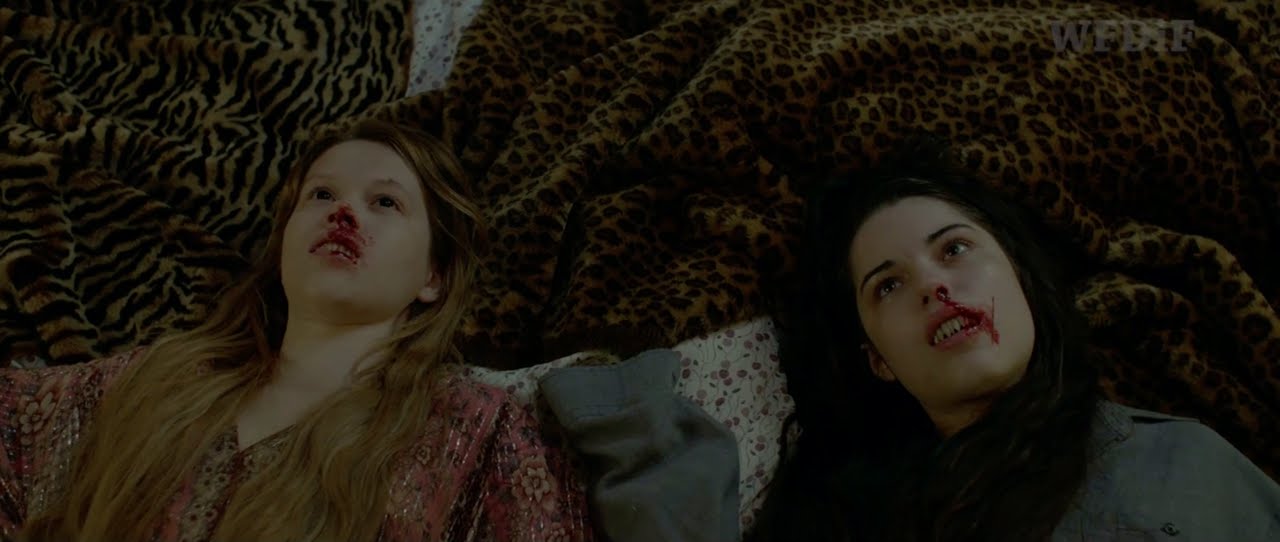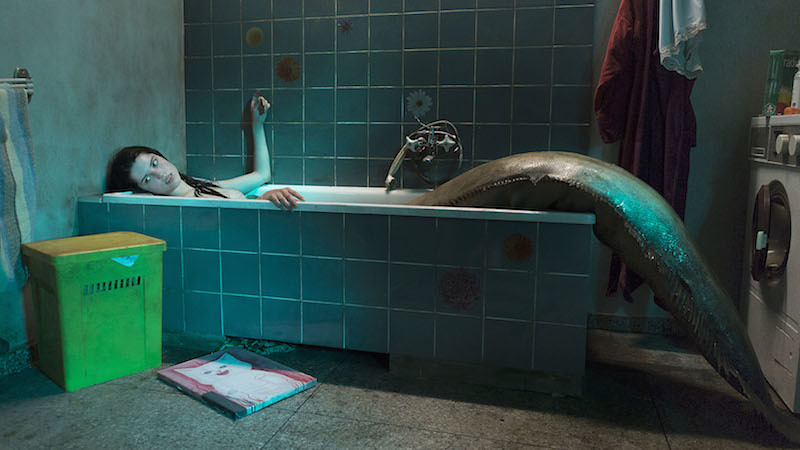
“The song of the Sirens, Cobera, does not exist; the music that cannot be escaped is in their voice alone.” – Giuseppe Tomasi di Lampedusa, The Professor and the Siren
Before the playwright and biographer Joan Schenkar penned the foremost texts on Dolly Wilde and Patricia Highsmith, she’d already written about another queer figure of literary merit: the mermaid. Published in a 1995 anthology of lesbian literature co-edited by Eileen Myles titled The New Fuck You, the short story “Operation Mermaid” centres on a woman rescuing her medically-harmed mermaid lover from a hospital. Her mermaid serves as an allegory for a handful of atrocities, including Dr. Mengele’s torture of sexual minorities, the institutionalization of queer people in freer societies, and even today’s continued incarceration of transwomen in male-only facilities. In the sea of stories of mermaids gone wild, Schenkar’s is one of many. Having been raised on these aquatic creatures, I’ve come to expect a lot from them: I want songs, iridescence, and access to a world where the effeminate is ubiquitous. Luckily, women like Joan Schenkar and Agnieszka Smoczyńska are eager to pick up the mermaid mythology where the last storyteller left off.
The Lure, Smoczyńska’s 2015 mermaid horror-musical, begins with a foreshadowing duel between land and aquatic songs. Figs ‘n’ Dates, a family of second-rate cabaret performers, relax on the banks of Poland’s Vistula River, strumming, singing and dancing. They aren’t the sort of band that has ever drawn an audience; tonight, the tide turns. From the waters, two mermaid sisters, the blonde Silver (Marta Mazurek) and brunette Golden (Michalina Olszanska), leering, begin a song of their own: Help us come ashore, no need to fear. We won’t eat you, my dear. Eat you, eat you…
Entranced, the father (Andrzej Konopka) and son (Jakub Gierszal) abandon their instruments and wade into the water, hands extended in besotted chivalry. The mother (Kinga Preis), unfazed by the mermaids’ song, pierces the night with a scream. Within a minute’s time, The Lure’s rock, paper, scissors-style power dynamics are established. Positioned as back-up singers and stripteasers in the family’s act, it isn’t long before the sisters usurp Figs ‘n’ Dates by baiting the hook with their own beautiful bodies; mermaid nature isn’t too different from the femme fatale understanding and manipulation of male desire. The Lure, Silver and Golden’s band, is cooler and shorter-skirted, drawing the obsessive fans that Figs ‘n’ Dates cannot. When the viewer realizes what Smoczyńska is cheekily telling us about gender, the question of whether or not the mermaids’ song is manipulating audiences becomes irrelevant.

The story of mermaids, selkies, sirens and their cousins is as mutable as the water through which these mythical creatures swim. Before Hans Christian Andersen wrote the dark fairy tale on which The Lure is loosely based, Homer’s sirens offered wisdom in the form of one’s greatest flaw and desire. 20th-century Europe gave us the mermaid as an emblem of otherness and the effeminate. According to Greek mythology, the siren’s hypnotic song causes the most virile of seamen to wreck their vessels on the jagged coast. The use of music to illustrate this seductiveness isn’t particularly new, but no less clever. Antonín Dvořák’s often-performed opera Rusalka (1901) employs song, as does Alan Menken’s steel drum-heavy score for The Little Mermaid (1989). The Lure (scored by Barbara Wrońska, Zuzanna Wrońska, and Marcin Macuk) pairs 1980s disco and punk with the film’s eschewing of the tiresome archetypes between which the mermaid is so often wedged (the Father, the Boyfriend), so that the film becomes a refreshing addition to the canon.
By causing identity crises in men and drawing reverence from women, the mermaid has always had a bit of a reputation for gender and sexual deviance. The early 20th-century lifestyle magazine La Vie Parisienne (1863-1940) made regular use of her as a cover girl. In one such illustration by Georges Léonnec from 1925, a mermaid, bare-breasted and piscatorially well-endowed, lies prone on a pond’s floor. She holds a sardine like a Gauloise and stares dreamily at the women skating on the frozen surface above. Hand to chest, she exclaims, “La Parisienne deviendrait elle économe? On voit beaucoup moins de pantalons, cette année!” Are Parisian women becoming thrifty? Seeing fewer panties this year! As women and gender studies scholar Emily Culpepper noted in an episode of filmmakers Casey Wagler and Sasha Wortzel’s radio show Romantic Friendship, the mermaid inevitably swam to North America and was appropriated by 1970s lesbian feminist subcultures. “The Boston Graphic Women’s Collective made posters for demonstrations, concerts and art. They had a wonderful image of mermaids that was very popular; you could tell that these mermaids were from diverse racial backgrounds,” she says. “There was also a very popular play called ‘Mermaids’ in which mermaids were an image for the free-thinking of the central character.”
While essential to The Lure’s conventional plot structure, the power struggle between the sisters and their aged and opportunistic sponsor family feels secondary to Silver and Golden’s relationship to human flesh: Silver wishes to transition into it so the bassist Mietek will fall in love with her (a perilous move, as romantic failure could result in her turning to sea foam). Meanwhile, Golden’s carnivorous bloodlust intensifies. One sister’s greatest pleasure becomes the other’s greatest repulsion, driving a wedge between them. As with in-fighting that occurs between modern feminist circles about pornography, trans rights or liberal political candidates, Silver and Golden’s conflict isn’t their doing. The two are pitted against one another because the “female body” as they know it, a tremendous half-fish and half human form, when sized up against men—by men—is inferior; a curiosity cabinet object at best, a bounty-hunted carcass at worst.
The Lure viewer has a choice: accept total erotic defeat, or admit […] that their desire skews a bit bestial.
Before the club manager (Zygmunt Malanowicz) sees Silver and Golden for the first time, he smells them. He saunters from room to room, nose wrinkled and hands shoved into the pant pockets of his double breasted suit, suspicious of each woman he passes. The moment quietly and deliberately evokes every juvenile remark a man’s ever thrown around about the area between a woman’s thighs smelling like a fish market. There’s a similar, though less self-aware, moment in Curtis Harrington’s 1961 thriller Night Tide. The sailor Johnny Drake (Dennis Hopper) is enjoying a romantic al fresco meal with his new down-low mermaid inamorata Mora (Linda Lawson). She inadvertently compromises the mood by serving him a whole, raw fish. While Vilis Lapenieks shot the film in black and white, you can still feel Drake’s face turning green with nausea.
These age-old comparisons between pussy and pescada are not always derogatory. In Giuseppe Tomasi di Lampedusa’s short novel The Professor and the Siren, an aging intellectual, Senator Rosario La Ciura, tells a young man named Paolo Cobera about the passionate affair he had with a mermaid during his youth. La Ciura, craving sea urchins from Cobera’s region of Italy, exclaims, “They are the most beautiful things you have down there, bloody and cartilaginous, the very image of the female sex, fragrant with salt and seaweed… What flavour! How divine in appearance!”
Back in The Lure, the manager follows his nose and finds two girls in a dressing room, jumping on a casting couch and singing along to the Donna Summer disco hit that the Figs ‘n’ Dates matriarch performs onstage. But they aren’t actually girls. Silver and Golden, escorted from the Vistula’s waters, have transformed into quasi-women with legs having replaced their fins. The father eventually arrives on the scene, pushing the mermaids’ knees apart and turning them 360 degrees so the manager can see all there is to see—which is to say, nothing. Smoczyńska’s joke is on the “fish market pussy” joke itself, as the mermaids, when presenting as humanoid, don’t actually possess visible sexual anatomy; everything down there is as flat and sewn shut as a Mattel doll. The sequence punks the obsession/repulsion with the vagina by courting the desire for hairlessness, symmetry and cleanliness to the extreme, and then denying the titillated voyeur entry. It is only after the father upends a dirty glass of water (its own sort of metaphor for arousal and authenticity) onto Silver and Golden that their fangs and eel-like tails unfurl, the latter taking up six times the space in the room than their normative girl bodies did seconds before. After the transformation, the manager is quick to probe the slimy new vaginal opening running parallel to Silver’s tailfins with an unsolicited finger. When the father acknowledges that the sisters do indeed smell fishy, the manager concedes, “It’s not that bad.” The Lure viewer has a choice: accept total erotic defeat, or admit, like La Ciura or the manager, that their desire skews a bit bestial.
One of Silver’s most pivotal scenes is unusually subtle, void of a musical number save for the banal hummings of a vacuum cleaner in the wee hours. The more sensitive mermaid, in love with Mietek and weighing the merits of becoming a landwoman, is summoned by a club employee played by Iwona Bielska, the accomplished Polish actor whose husky voice and suave movements give Kathleen Turner a run for her money. As she offers Silver—who has never smoked before—a cigarette, her seasoned femininity eclipses the young mermaid’s. “You want to have a pussy,” she observes, causing Silver to hack. “You know it’ll make you lose your voice,” the older woman continues, taking another puff.
This harbinger is kaleidoscopic: it’s ambiguous whether she is warning Silver of the dangers of smoking, of pursuing human anatomy or the loss of autonomy that all too often comes with owning a mortal pussy. It’s also unclear whether she knows this from experience, either as a former mermaid or as a transwoman (the two identities grow more and more similar as the story unfolds). If The Lure possessed an Ursula, a Divine-inspired antagonist hell bent on having dominion over the sea or stage, it would certainly be Bielska’s character . If The Lure possessed a response to Ursula, a Divine-inspired antiheroine who cautions impressionable young things against assimilating into the mortal man’s cruel, ironclad gender binary simply for love of another, it would also be Bielska’s character. Apart from Tryton (Marcin Kowalczyk), the land-committed merman who fronts a metal band and befriends Golden, we receive neither. After her time as a spot-on oracle is up, we never hear Bielska’s haunting timbre again. Later, Silver takes her chances with a transformative procedure that has a far-from-fairytale ending.

To disregard this saccharine 1989 Disney adaptation of Andersen’s The Little Mermaid would be as pointed of a countercultural sin as ignoring the mermaid entirely. A litany of millennial queers assert that the animated Ariel is their “root,” the singular figure who facilitated one’s earliest nonconformist thoughts. Her credibility, despite being animated and sanitized, sizes up to Silver’s quite well. “Ariel was a trans girl. Her toys were a secret collection of human artifacts, similar to me playing with my sister’s Barbies, a way to access the identity I belonged in,” writes Feministing’s Jos Truitt.
As her sister contemplates her own body, Golden considers those of others. Lonely, she cruises the Warsaw club scene for men to eat, crooning, “At night I get cravings that aren’t quite wholesome.” This murderous archetype is one that Olszanska has mastered. In Jacob Chelkowski’s 2014 short Tiger, she is a sphynx cat belonging to an amoral man, suggestively lapping milk, enjoying scritches, and gazing until the time comes to lethally pounce. Similarly, Golden taunts her prey beforehand by sitting pretty, remaining silent except for a sound that resembles a purr. When men get too close, she hypnotizes them into stillness. Golden’s first trick takes her to a lover’s lane, and it isn’t long before screams are heard from inside his red sedan, then silence. She emerges in her fully aroused form and slithers into the water with his heart between her teeth.

Eventually, Golden’s fleshy hunger for men and sexual appetite for women become inextricable. One of The Lure’s devotees is a detective (Katarzyna Herman), a stoic, red-lipped femme investigating the disappearance of the fellow who Golden devoured. When she confronts Golden, the mermaid begins a girlish solo that swells into a romantic duet; they share a cigarette and, unlike her sister, Golden inhales effortlessly. Herman’s character extolls her as both mother and lover, promising her Disneyland. These sweet nothings evoke more queer observations about Disney’s The Little Mermaid.
“I collected gay culture, researched, and read anything Google would point me to on ‘how to be a lesbian,’ but I wasn’t actually a part of that world yet,” one blogger notes, comparing her coming of age plight to Ariel’s. Or, as AfterEllen contributor Lucy Hallowell humorously argues in her listicle titled “Our 8 Favorite Lesbian Disney Characters”, “She’s going to risk losing her voice for a pair of legs (the better to scissor you with, my dear).” A decade after The Little Mermaid, Kim Cummings rendered connectivity between lesbian adolescence and the mermaid visible in the tender short film Weeki Wachee Girls (2000). In a world not too far removed from the Disney kitsch and sprawl of Sean Baker’s The Florida Project (2017), two teens aspire to become mermaids in Weeki Wachee State Park’s sideshow act. The dream trembles when one of the girls discovers her best friend is queer; femininity, friendship and appearances are all called into question.
Golden and the detective’s number is lush, physical and full of choreography mirroring playground games. The song roams through Warsaw’s streets, the older woman’s car and then her dark bedroom, where—in stark contrast to the father’s earlier dousings in harsh fluorescent lighting—she hands the mermaid a glass of water to pour onto herself. Golden, whose name is not lost on those familiar with the “gold star lesbian” pejorative, indulges in an erotic encounter that is everything Silver’s attempts at sex with Mietek (who is continually squicked out by her fishiness and, post-operation, her menses-esque bleeding) are not. The mermaid, in this intimidating form, seems to be better suited for sex with ciswomen than human cismen, who are tainted by patriarchal doctrine. The detective relishes her conquest’s exoticism; she runs her tongue across the spines of the mermaid’s tail, then straddles her in a way that is so efficient, perhaps more efficient than any way that two humans or merpeople alone could ever have lesbian sex. And while there is no blood, there is a threat of it as the detective flashes her gun; Golden, her teeth. Questions are raised about the bestial traits that naturally inhabit queer women’s daily existence; questions that, given our unrelenting adoration for the mermaid, won’t go unanswered for long.





